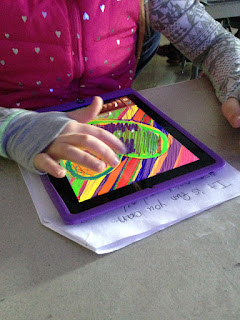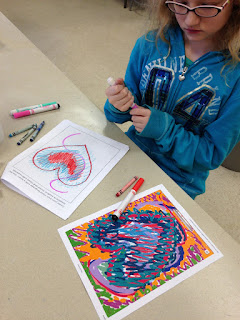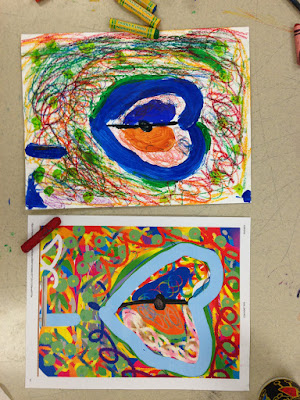Learning to Look, Play and Think
with
Jim Dine
Jim Dine is one of those "go-to" artists in an elementary school. Specifically his infamous "hearts" have become a staple in February, across elementary art rooms. From young, first grade students, to older sixth grade, we (art teachers) use this perfect little shape as a platform for making art.
I am guilty of using Jim Dine as inspiration and his perfectly, imperfect hearts, but this year I thought about the project a little differently. The fourth grade curriculum that I designed focuses my students' attention on critically looking at artwork and studying why and how, artworks are made, through the lens of an investigator and an artist.
 DAY ONE:
Prior to even entering the art room, I started my students with one simple direction..."follow the direction on the board and in your packet. You have 10 minutes to do what it says". With hesitation, uncertainty and a little confusion, my students entered the room, read the direction, "draw a heart". They had ten minutes and an assortment of materials to "draw a heart", is all they had to do....
DAY ONE:
Prior to even entering the art room, I started my students with one simple direction..."follow the direction on the board and in your packet. You have 10 minutes to do what it says". With hesitation, uncertainty and a little confusion, my students entered the room, read the direction, "draw a heart". They had ten minutes and an assortment of materials to "draw a heart", is all they had to do....
But did they?
 The results of their 10 minute drawing were predictable. Most drew the simple shape of a heart and filled it in with red or pink. As we took a "gallery walk" around the room, each student noticed that although the hearts were "different" they were also very much the same. The important component to this activity was discussing "why".
The results of their 10 minute drawing were predictable. Most drew the simple shape of a heart and filled it in with red or pink. As we took a "gallery walk" around the room, each student noticed that although the hearts were "different" they were also very much the same. The important component to this activity was discussing "why".
"Well, because we just always make hearts like this".
"Why?", I asked.
A question, hard to answer.
 This quick exercise started my students on their way to understanding an artist's process and understanding how materials work, through experimentation and "play". It, also, gave me a quick snapshot of my students' risk taking meter. My goal, throughout this unit was to encourage my students to take risks and step outside their comfort zone. And to THINK! (without me at the helm).
This quick exercise started my students on their way to understanding an artist's process and understanding how materials work, through experimentation and "play". It, also, gave me a quick snapshot of my students' risk taking meter. My goal, throughout this unit was to encourage my students to take risks and step outside their comfort zone. And to THINK! (without me at the helm).
 With Jim Dine, we started by skimming through a Scholastic Art Magazine article to find some basic information about the artist. I did not provide my students with much visual information, because I did not want them to be influenced immediately by Jim Dine's work. Instead, I had them "play".
With Jim Dine, we started by skimming through a Scholastic Art Magazine article to find some basic information about the artist. I did not provide my students with much visual information, because I did not want them to be influenced immediately by Jim Dine's work. Instead, I had them "play".
 |
| abstract from packet |
 For the remainder of day one, students collaborated with their table mates, experimenting, playing and discovering new approaches to art-making. The experience opened the door for discussion and debate, filling the art room with wonderful noises of movement, talking, scribbling and "playing". This led to a homework assignment:
For the remainder of day one, students collaborated with their table mates, experimenting, playing and discovering new approaches to art-making. The experience opened the door for discussion and debate, filling the art room with wonderful noises of movement, talking, scribbling and "playing". This led to a homework assignment:
 |
| abstract from student packet |
 DAY TWO:
DAY TWO:
In this art unit, I wanted to incorporate a technology component to my students' art-making experience. I wanted the focus of the digital component to be a
tool for developing their creative process, not solely to use iPads in the art room. In planning this component, I asked myself, "How would this experience benefit their overall understanding of the art-making process and enhance the students' creative thinking"....."What's the point?". My response (to myself) guided the sequence of the unit and my students' exploration of materials and their properties.

On DAY TWO, I arranged to use iPads in the art room and the App: Drawing Pad. The students' objective for the day was to "play" with 5 art materials offered through the App: paint, colored pencils, drawing pencils, crayons and markers. Parameters: Students needed to utilize all 5 art materials and there was no erasing or starting over.
My students LOVED it....of course, but little did they know I had other plans up my sleeves for them;-)
Upon completion, I printed their digital works for the following days.
DAY THREE:
My sleeves revealed their hidden surprises!
We started the session with an overview and survey of Jim Dine's infamous hearts, looking at them with a more critical eye. Throughout the whole group discussion, it was refreshing to hear how their new knowledge and understanding of materials translated into their understanding of possible ways Dine created his art-works and visual language. The students broke down what they saw in Dine's artwork into processes, techniques and materials...even theories of Dine's art-making sequence. They no longer saw a heart, but rather they saw a thought process.
 Now it was time to challenge their 4th grade brains again!
I distributed their digital hearts. The students were simply thrilled to see what they came up with actually printed and in their hands. Yet, the enthusiasm slowly turned into anxiety when I broke the news to them.
Now it was time to challenge their 4th grade brains again!
I distributed their digital hearts. The students were simply thrilled to see what they came up with actually printed and in their hands. Yet, the enthusiasm slowly turned into anxiety when I broke the news to them.

"Great! I am so glad you are happy with your digital art-works. Now, you have 25 minutes to re-create them with "real" art materials, using the same materials you used on the iPads. And no erasing, no starting over", said Mrs. Angelopoulos.
"WHAAAAAT?" said all the students.
"Go", said Mrs. Angelopoulos and the scurry of students started!
Paints were splashing, students were moving swiftly throughout the art room, discussions were taking place and I was watching as time ticked away and my students worked really hard :)


After the dust settled, the room was cleaned and the students finally sat down again, there was question, "Which method was more successful towards creating visual language"?
The polls were split.
When I asked, "which one was more challenging", all hands pointed to the 'real materials'.
When asked, "Why", the resounding voice was "because we had to move around and figure things out".
"Oh really", said Mrs. Angelopoulos, "wait until next week" ;-)
The project continues....follow my students and classroom on
Instagram :)
xoxo,
Smock Room






































































